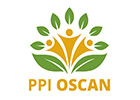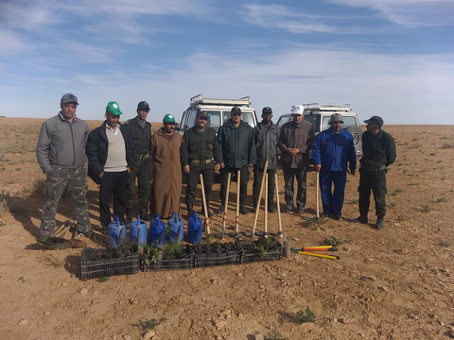The oasis of Aîn Sefra in southwest Algeria is surrounded by impressive and diverse landscapes, from desert dunes, to mountain chains and stepparian ecosystems. Both nomadic and semi-nomadic populations cross this region to find grazing sites for their livestock at the bottom of the Ksour Hills. Livestock farming and agriculture are indeed the main economic drivers of this region, where « Terre Verte » – an association created by direct descendants of shepherds and environmental educators – is working to conserve nature.
Over the past two decades, climate change and desertification have increasingly hit this region, causing a significant loss of biological and economic productivity. Sand encroachment (affecting 20% of the land between 1975 and 2016), overgrazing and erosion are some of the key threats for the economic activity of the local population.
To adapt and protect the ecosystem against droughts, the native population applies some traditional methods, such as building water reserves in the soil or constructing rainwater reservoirs for agriculture.
Thanks to their knowledge on the use of endemic species such as Pistacia Atlantica and Needle Grass (Stipa tenacissima) as well as reforestation practices, the Terre Verte association is working to restore its local ecosystems, control desert expansion and preserve fertile land for agriculture and livestock. The project also supports nomads, shepherds and the local community in planting fodder species to preserve grazing areas, as well as planting needle grass in closed spaces to ensure the production of seeds.
The use of Pistacia Atlantica to combat drought and desertification
Classifed as a ‘Near Threatened’ by the IUCN Red List of Threatened Species, Pistacia Atlantica is a highly resilient species that can survive the Sahara’s arid climate thanks to its pivoting roots, used as a means for restoring altered and degraded environments. For example, it is used to create ecological corridors due to its ability for connecting ecosystems.
« The few needs and high resistance both to drought and high temperatures make Pistacia Atlantica a popular species for planting in parks and gardens. Hence, we need to preserve and develop it to face desertification and drought as well as mitigating climate change effects », explain the members of the association.
Pistacia atlantica not only strengthens the soil, but also protects the land against erosion and landslides, making it possible to replant arid lands. This strong resistance to drought and strong winds also makes it an ideal to feed the cattle and animals of local populations, thanks to the oleaginous fruits it produces. Some other of uses of this species by local populations include antiseptic and antifungal remedies, as well as cosmetics.
Needle Grass – Vulnerable, yet essential for their ecosystem
« The first reason that motivated Association “Terre Verte” to preserve Stipa tenacissima was to stop the degradation of steppic zones, and 90% of the needle grass layer in the Aîn Sefra region » explains Farida Aitkaci, national coordinator of the PPI program- OSCAN in Algeria.
Needle Grass, also known as the Queen of the Steppe, is also a very drought-tolerant species that stops the expansion of desert dunes and therefore keeps the land fertile. Although it has been one of the dominant elements in the Algerian steppes for many years, it is today considered Vulnerable according to IUCN Red List (VU). The main reasons for this situation are overgrazing, illegal tillage and general human impact. Abusive uprooting and its heavy use in the craft industry are also threatening factors.
For over 4,000 years, this endemic species from the Maghreb, Andalusia and southern Portugal was given multiple uses. However, in the twentieth century, the the massiv use of plastic and other imported fibers led to a fall in the exploitation of its resources.
« Once spun, the fiber from leaves is generally used to make baskets, colanders, carpets, baskets, sieves, couscous makers, and liquid containers, to keep mil, for example. Besides, traditional Needle grass carpets are very well knoen. »
Replanting these species through a bank of seeds
In order to preserve agricultural biodiversity, the members of the association have set up a Pastoretum – a bank of seeds in which the genetic resources of cultivated plants and wild species are stored. This technique is widely used to support the dissemination and reintroduction of these species.
As a part of their PPI-OSCAN project named « Pastoretum for the preservation of the pistachio tree of the Atlas and the Alfa », the members of Association « Terre Verte », have extended their initiative to protect these two species from the Saharan regions to the Northern Mediterranean. The first Pistacia Atlanticas were provided by the Ecology Lab of the University of Sidi Bel Abbés which would become a part of the plant nursery supporting the replanting activities of the association.
« The development of our plant nursery and a small seed bank are a true accomplishment of our project. It has become a true supplier of pistachio plants through the dissemination of nearly 1,500 seedlings, to sheperds in the Aîn Sefra region, and even beyond, in other communes of Naâma and in the wilayas of Biskra d ‘ El Bayadh and Béchar » explain the members of the association.










